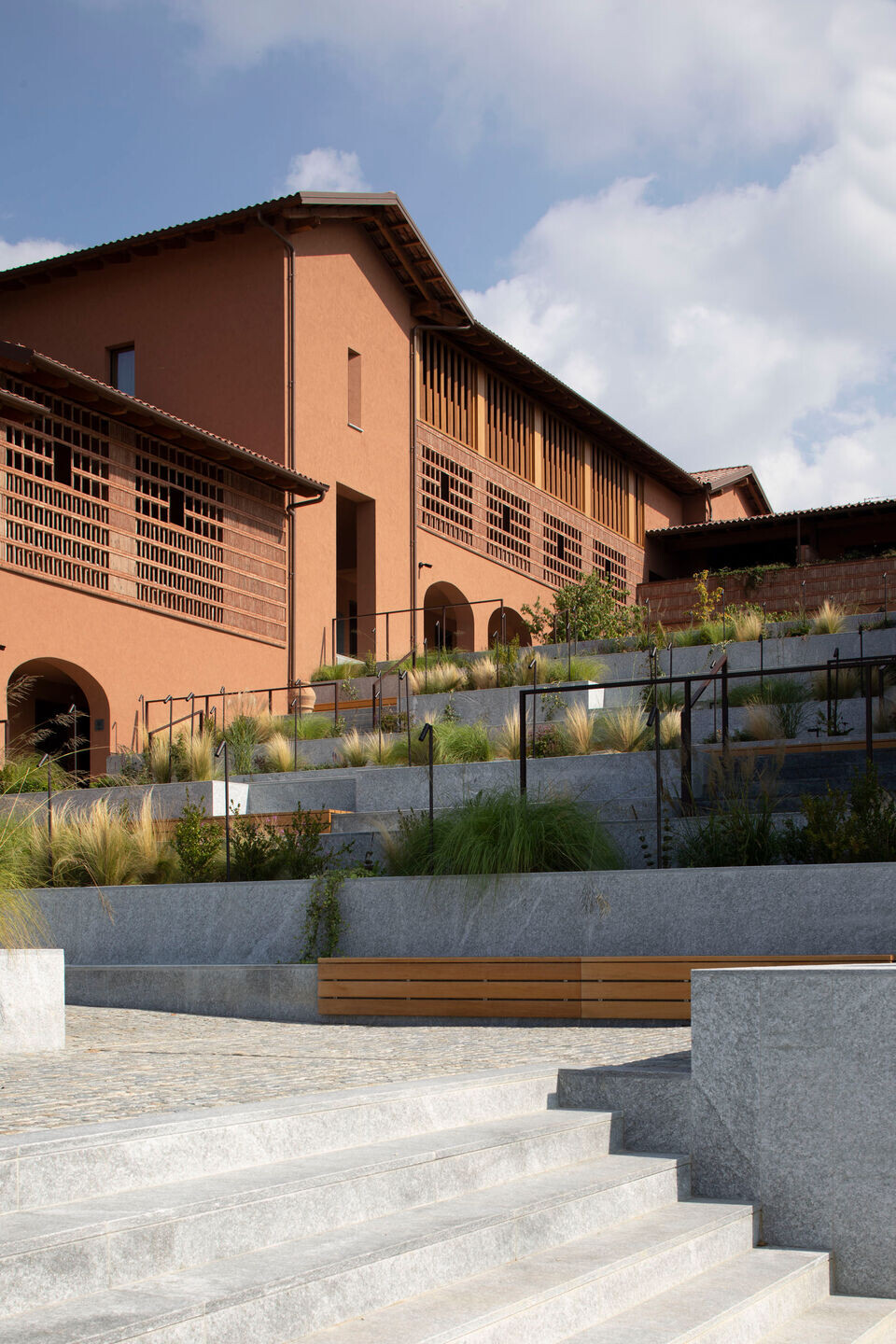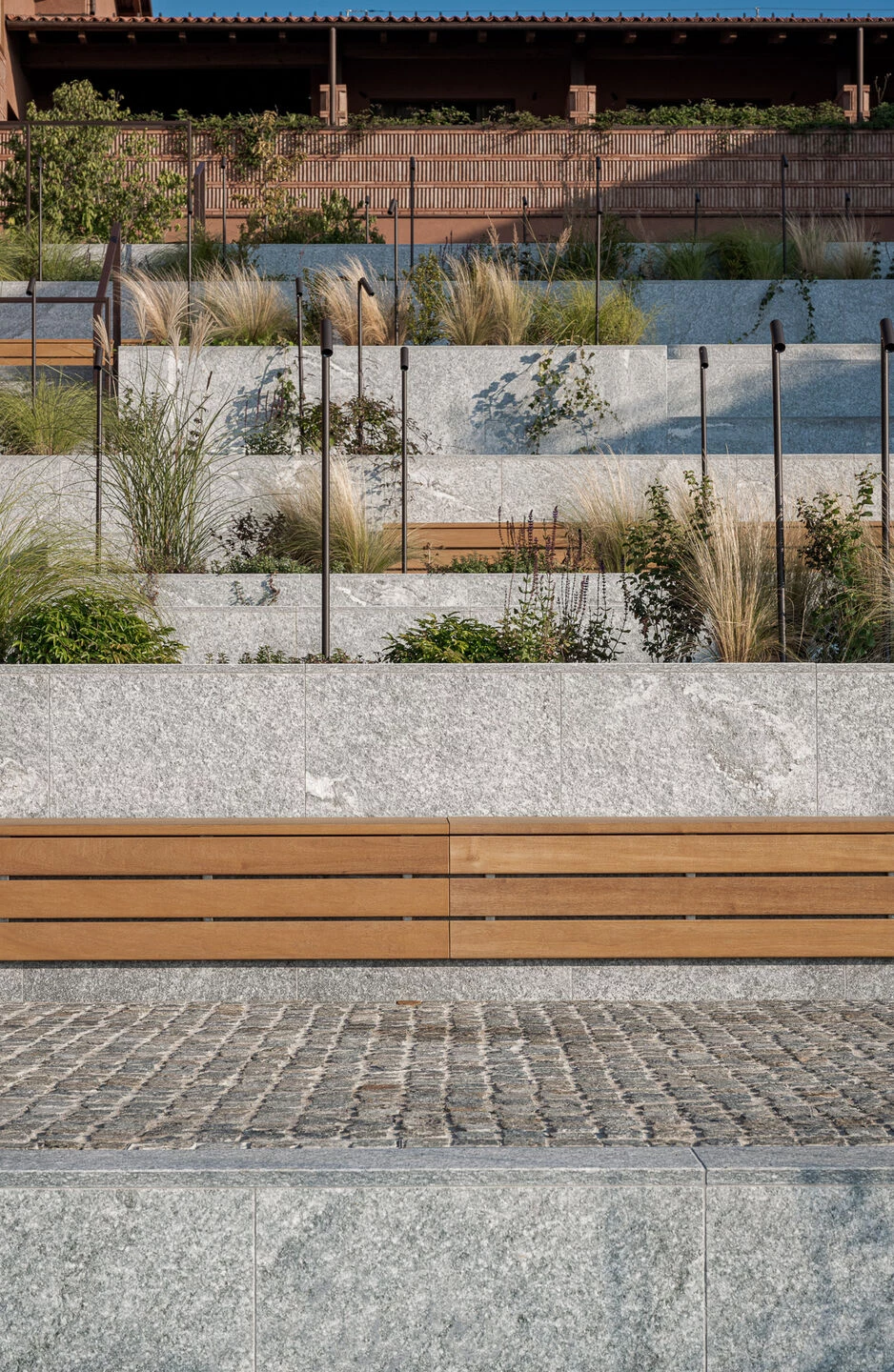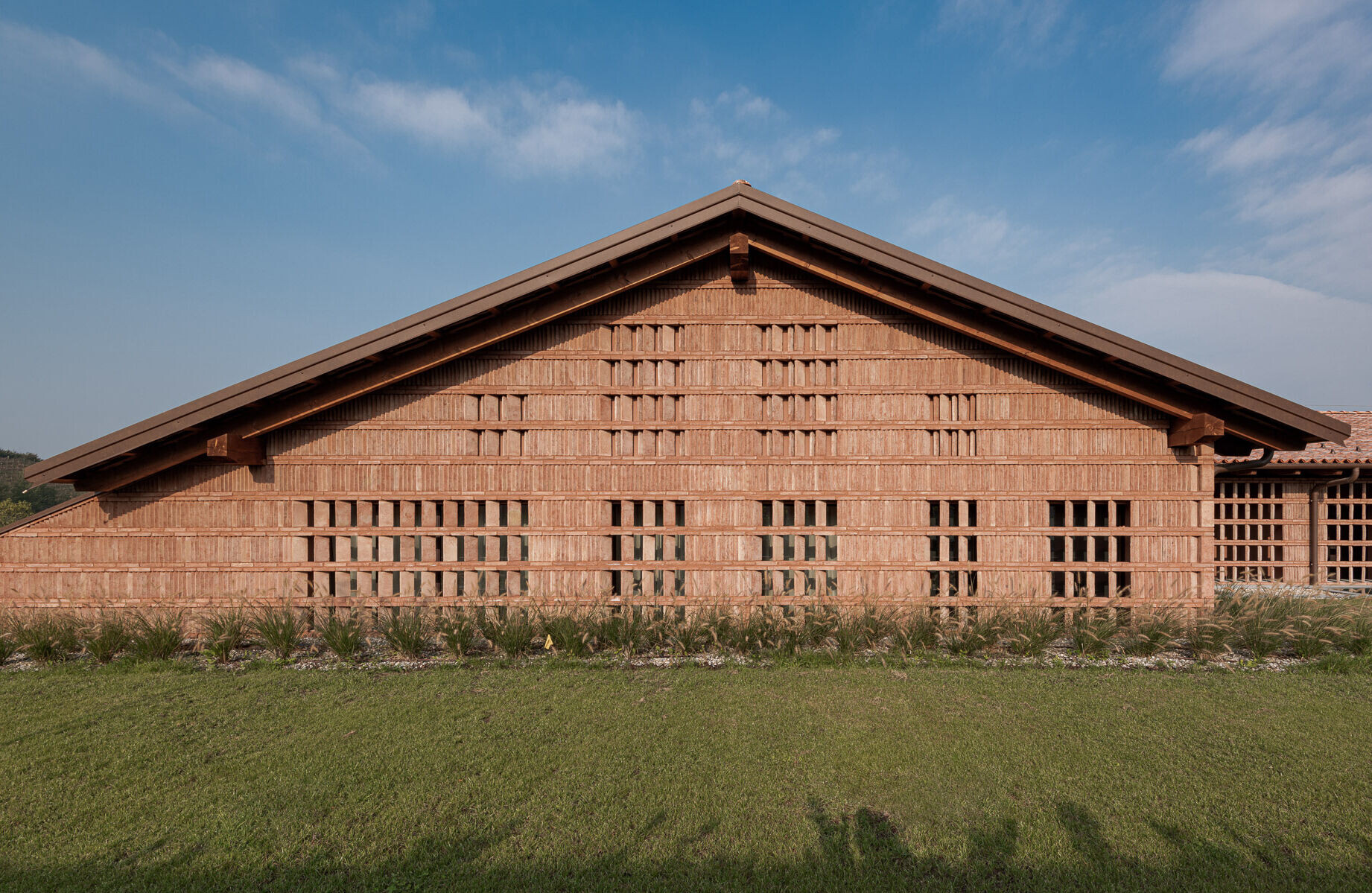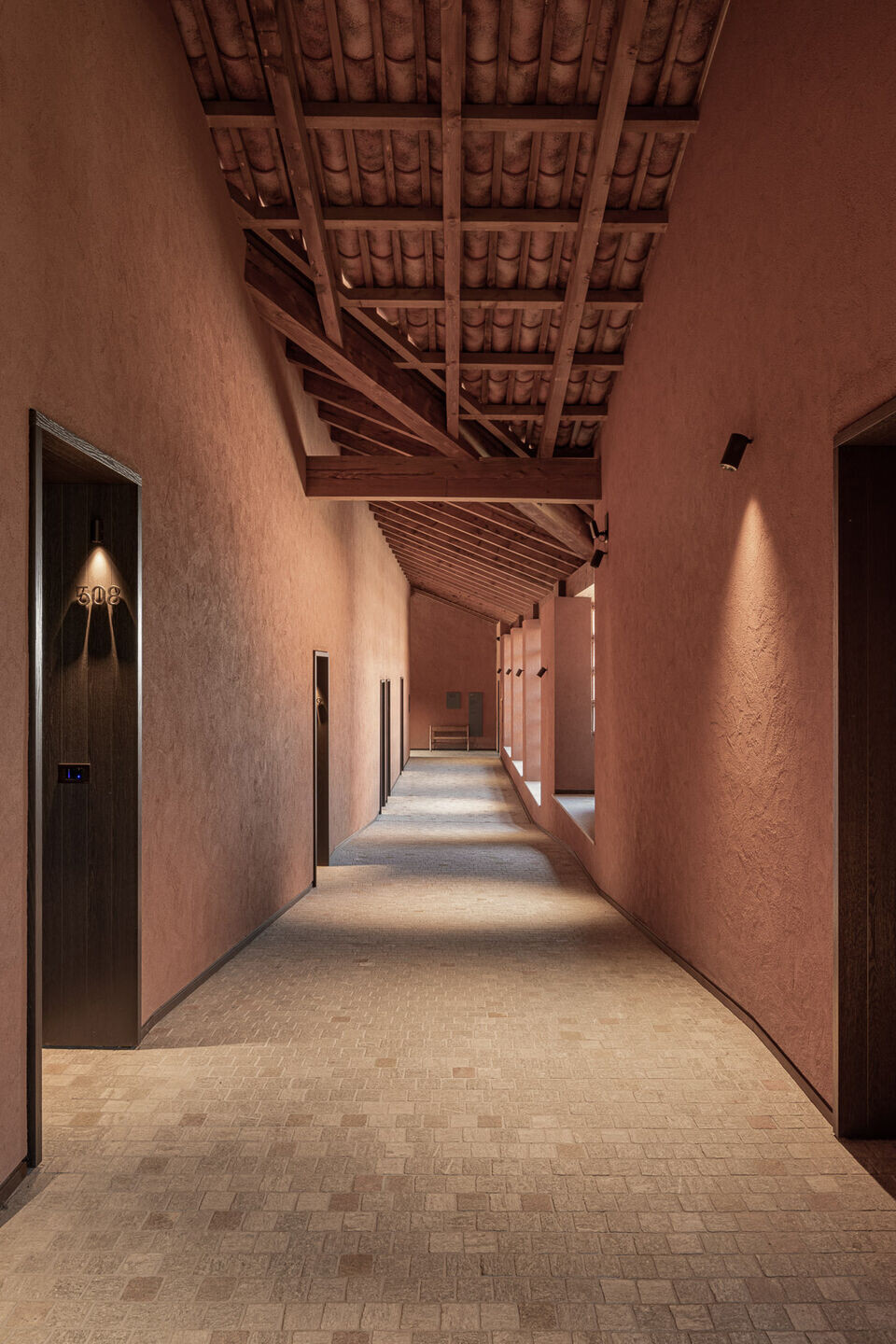Design by GaS Studio with Parisotto+Formenton Architetti
June 2021 - Casa Di Langa, the new sustainable luxury resort, opened to public in June in the heart of the Langhe region. GaS Studio with Parisotto+Formenton Architetti is the Milanese team that designed the architecture and interiors. The hotel, part of a property that includes 104 acres of vineyards, hazelnut groves and forests on the slopes of the Piedmont hills, offers 39 guest-rooms and suites and combines a contemporary design inspired by local rural traditions with many eco-sustainable practices and tailor made experiences for an authentic Italian luxury stay.

Casa di Langa is owned by the Krause group, an American company lead by Kyle J. Krause - President and CEO - who has a true passion for Italy, where part of his family originally came from. He chose an Italian design team for this project with the precise goal of creating a high-end destination where luxury meets design with a special eye for the respect of the territory and the local heritage.
The project, a positive cycle: reuse and improvement of a pre-existent building
The project approach conceived by GaS Studio with Parisotto+Formenton Architetti is based on sustainability and a deep respect for the natural world. Partially built in the early 2000s on a property of vineyards, orchards and forests and left unfinished, the building’s redesign centers around the maximum reuse and adaption of the existing structures while completely revolutionizing the guest experience, from circulation to a new distribution and balance of guest services.
A fundamental ingredient of the new design was that of intimately connecting the building to its surroundings. The aim was to embed the resort in the landscape through an architecture that visually communicates connection and harmony between the intervention of man and nature. Re-envisioning the distribution of main circulation elements to the courtyard side of the complex enabled elevator access to all floors and rationalized circulation flows, providing guests with a direct connection to the countryside and its breathtaking views while preserving the privacy of their rooms. The design was inspired by a profound respect for the region and its heritage and a desire for authenticity, combined with a contemporary twist in the details and extreme care in choosing materials and colors. Locally sourced and recycled materials, as well as other ecologically responsible choices were made to preserve and improve the site.

From an architectural point of view, the building develops in a C-shaped plan around an open piazza that cascades down the hillside in a progression of terraces towards the valley. The three wings of the building frame the breathtaking view that can reach as far as the Monviso peak.
The structure, inspired by the rural architecture of the region, integrates local building traditions and is intended to stand the test of time. What looks more as a contemporary reinterpretation of the traditional elements are the arched porticos on the ground level, the external corridors screened by brick filters that ensure shade and ventilation and the typical red roof tiles.
The design team, starting early in the competition phase, did an extensive research of the dominant colors of Piemonte. Nature in the various seasons, soil and foliage, ancient cities and villages, all contributed in the final material choices and colours. Stones, plasters, paints, textiles, all were carefully selected to remind one of the surrounding landscape of the Langhe and left “imperfect” to further connect the architecture to the rural context and add a tactile dimension to the structure.
Vertical exterior elements are monochromatic. Stucco, brick, wood and roof tiles are all shades of deep red whereas all exterior horizontal surfaces are mono-material: Lucerne granite, but in multiple textures ranging from slabs to blocks and pavers to gravel. In the interiors the atmosphere is warm and welcoming, thanks to the neutral colors of the natural-based plasters and the use of wood and stone.
The DNA of Casa di Langa: sustainability, respect of nature and promotion of biodiversity
The entire project is centered on a profound respect for the region and aims to be as sustainable as possible and a model for eco-friendly resorts. A commitment to a sustainable future is the backbone of Casa di Langa's mission and design, one that includes carbon neutrality, use of 100% recycled water for irrigation, and most importantly, being good stewards of the land. Located in a UNESCO World Heritage listed site, Casa di Langa is part of a region known for its cultural landscapes, wine growing and winemaking traditions (also home of the famous white truffles). The vineyards and hazelnut orchards of the hotel are part of a long history of continuous improvement and adaption; forty new beehives have been installed to promote natural pollination and reforestation was carried out within the property in order to increase the presence of trees in the area contributing the further preservation of the territory.
The most evident decision that favored the re-use of embedded energy and which minimized environmental impact, was the adaptive re-use of an existing structure. New exterior materials were sourced nearby: the local granite quarry provided Pietra di Luserna stone for a variety of paving textures, wood was harvested sustainably and FSC certified, and the interior finishes were all sourced within Italy.
Casa di Langa’s design blurs the line between interior and exterior, combining exterior open-air corridors with a courtyard that steps gently down the slope and is fully accessible. Day-lighting is controlled using an age old tradition of brick brise-soleil, which also keeps the building shaded and cool reducing energy consumption; Rainwater from the roofs and piazzas is collected and used for irrigation of the vineyards and landscaping. Indoor fixture flow-rates are at least 20% more efficient than current Italian codes.
Furniture has been carefully selected amongst the top Italian brands promoting Made in Italy quality; guest-rooms offer mattresses produced with the use of natural materials (cotton, wool, silk) guaranteeing comfort and relaxation.
The restaurant Fàula processes organic waste to produce compost for the vegetable garden and fruit orchard thereby offering guests natural and unprocessed organic produce; while in the whole resort no disposable plastic is used.

The added value for a post-Covid hospitality
The resort is located in a rural setting, far from big cities, immersed in silence and nature. A perfect destination for a hideaway and for those seeking quiet and relaxation. The architecture of Casa di Langa is focused on the land and magnificent views that surround it. And as such all rooms and public services spill out onto exterior areas with varying degrees of privacy corresponding to their function. Corridors are open-air yet fully protected from the elements by either an arcade, open brick screening or wood brise-soleil. All rooms and suites offer large, covered and private loggias, that can be enjoyed almost year round and provide open air lounges in full privacy and with amazing views of the panorama.
The desire to connect to the surrounding landscape and encourage its exploration was a clear objective of the design team. This aspect was further reinforced by the pandemic and points to the importance of exterior spaces as an essential element of our quality of life and a tool for dealing with changing future needs of resort guests.
A contemporary resort between tradition and landscape
Casa di Langa is surrounded by 42 hectares of land cultivated as vineyards, orchards, hazelnut orchards and vegetable gardens, it offers 39 guest-rooms and suites as well as a Spa & Wellness center, a gym, an outdoor pool, a “bocce” pitch and a detached country villa that can be rented for private events and receptions.
It looks like a private countryside estate, with a contemporary style despite the strong local connotation of its rural inspiration: A mix of Nordic and Italian furniture is used in the interiors - signed by great masters or contemporary designers - some vintage pieces are matched with clay vases hand-made on commission by Italian ceramists and an impressive collection of artworks by internationally renowned contemporary artists is located in the resort and in the gardens.
The new resort is firmly tied to the territory and its traditions: framed views, materials, colors, details were studied to enhance this authentic link and enrich the experience.
In addition the hotel offers a high-end gastronomic experience under the guidance of Manuel Bouchard, a local chef with international experience and a wine cellar to sample internationally recognized local wines.
Architects and landscape designers worked together to create a unique place
Casa di Langa is nestled in its landscape and borders with the territory of Roero and Monferrato. The hotel is immersed in the famed wine-growing territory of the Langhe and is also in a UNESCO world heritage site.
The project is located within a cultural landscape, the result of the combined action of humans and nature. Landscape wise, the building and its extended functions want to fit harmoniously into the context, setting as its objectives the physical and visual connection with the context, the usability of all outdoor spaces even in a context with a complex morphology and the re-interpretation of the local language through new compositional forms. The project is part of a highly agricultural-productive context focused on the production of wine, truffle harvesting and the cultivation of hazelnut trees. The goal of the landscape project is to narrate these peculiarities, highlight their processes and invite visitors of the Hotel to explore them more closely. The landscape project is structured with a natural gradient that, starting from the central space of the building, fades outwards and towards the agricultural parts, with more rustic interventions. The plant species, materials and colors used are those of the typical Langa landscape. The system of open spaces of the hotel is divided into different areas, each of them is different in functionality, spatial and material characteristics. The areas of the landscape project are divided into connecting roads to the project and entrance area, Art Garden and SPA, terrace and central terrace, outdoor tavern and fireplace, terraced gardens and ‘bocce’ area, orchard and vegetable garden area, swimming pool and terraces on the upper floors.

The project - signed by Gas Studio with Parisotto+Formenton Architetti and built by Malabaila&Arduino - is the fruitful result of a collaboration that turned into an opportunity of mutual growth, exchange and enrichment. The four-handed project was developed with a sharing attitude, where creativity and different skills converged on the common objectives of aesthetic quality of the spaces and the best atmosphere for the stay of the guests.
“In all of our work we seek to manage meaningful designs that are responsive to clients’ needs, create memorable spaces that contribute to their communities and landscapes, and touch the land and the environment as gently and as positively as possible. Casa di Langa is evidence of these efforts and shows the excellence in design and sustainability that is at the heart of our practice and this project” shares Andre Straja, Partner at Goring & Straja Architects.
“The team we created was enriched by our different backgrounds and strengths - despite our somewhat differing orientations and experiences, the synergy we were able to create has been our winning formula. We experienced a real collaboration based on fruitful exchange and dialogue. Our combined efforts and partnership, we believe, is what has made Casa di Langa a huge success” shares Aldo Parisotto, Partner at Parisotto + Formenton Architetti (P+F).

Lighting design: a consistent approach
In keeping with the “custom” nature of the project, PSLab joined the team and were fundamental in the development of the lighting concept. Natural and artificial lighting collaborate and not only enhance each other but create a surprising transformation between day and night.
When the sun sets, Casa di Langa becomes a lantern emitting soft, under spoken light, screened by archways, open brick patterns and wood brise-soleil creating a vibrant play of solids and voids. Most exterior light sources are discreet in keeping with the rural nature of the site, the desire to minimize light pollution and the wish to preserve the moon lit landscape and it’s views; only the hotel’s central courtyard is emphasised given the concentration of amenities it serves (upper lounge and Spa, main circulation and access to elevators and the lower restaurant).
Thanks to the high quality of LED sources and refined optics, exterior lighting was achieved with very low energy consumption while providing excellent visual comfort and a warm, relaxing atmosphere.

































































